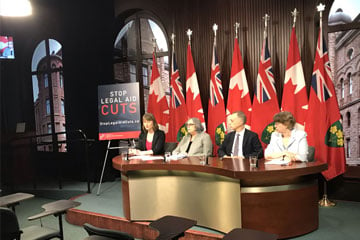
A number of lawyers spoke out in support of Legal Aid Ontario at Queen’s Park, saying the provincial government has released incorrect figures that are misleading the public about the number of clients it serves.

A number of lawyers spoke out in support of Legal Aid Ontario at Queen’s Park, saying the provincial government has released incorrect figures that are misleading the public about the number of clients it serves.
The lawyers — Dana Fisher, a Legal Aid Ontario lawyer and Society of United Professionals spokeswoman, Raoul Boulakia, president of the Refugee Lawyers Association, Ivana Petricone, policy counsel at the Association of Community Legal Aid Clinics, and Katharina Janczaruk, vice president of the Ontario Association Of Child Protection Lawyers — said Legal Aid Ontario is not serving 10-per-cent fewer clients than it was in 2013, as was claimed in a letter sent by the Ontario provincial government to justify budget cuts.
On April 12, Ontario Attorney General Caroline Mulroney sent a letter to CEO David Field stating there would be a cut of $163 million to Legal Aid Ontario’s budget. It was also announced with the provincial government’s 2019 budget on April 11. The letter also stated that, despite an extra $86 million in funding since 2013, the number of clients served each year by LAO has decreased by more than 100,000.
“LAO is unsustainable in its current state,” said Mulroney in the letter. Ontario Premier Doug Ford also echoed that figure when he phoned in to the Alan Carter Show on Global News radio show on April 22 and said, “There is more money being spent on lawyer fees and less cases [at the LAO].”
After going through LAO annual and quarterly reports and the most recent auditor general’s report, Fisher said there is no evidence to support what the premier and attorney general are saying. She said the auditor general found there was a 23-per-cent increase in the number of certificates issued by LAO between 2013 and 2018.
“That is indisputably more clients represented and not less,” says Fisher.
Petricone said that 95 per cent of her organization’s funding went to salaries for people providing those legal services, so in spite of Ford’s and Mulroney’s concern about fewer people being looked after, the cut of LAO’s budget will certainly mean fewer are served.
“We are funded in such a way that there is no fat; almost everybody who works in a clinic sees a client provides direct service. . . . It will mean we have to lay off workers and clinics,” she said.
The lawyers also disagreed with the figures used by the province.
Fisher said the LAO “provided service and representation” to 13,000 more people in 2017-2018 than in 2013-2014. Fisher said Mulroney has not provided a source for her claim that the LAO served more than 100,000 fewer clients in 2017-2018 than in 2013-2014.
“This claim is not true,” says Fisher. “Whether or not Doug Ford knows that, the statement is inaccurate. He has misled Ontario.”
According to the lawyers at the press conference, a possible explanation for the claim that LAO is serving fewer clients for higher pay is that in the auditor general’s report there was a decline of .6 per cent in “total service,” due to a drop of 18.1 per cent in “number of clinic files” from 2013 to 2018. In the report, it shows that there were 170,429 clinic files in 2017 and 2018, with an average cost of $503 versus 202,390 clinic files in 2012 and 2013 with an average cost per file of $357.
The auditor general’s report notes, however, that, in 2017-2018, LAO’s legal clinics changed their counting system. Prior to 2017, they counted as clinic files any services provided to clients — including “brief services, advice and referrals”— whereas after, the LAO counted only files where case representation was provided.
“So, Legal Aid Ontario gave clinics a different system for counting. That meant that we were now comparing literally apples to oranges,” says Petricone.
In her letter, Mulroney also included an excerpt of the auditor general’s 2018 annual report, which told of a lawyer who billed $150,000 to LAO from May 2013 to August 2016 using their daily rate policy of billing. This lawyer was found to have an office only five kilometres away from the court and so should have used hourly rate billing. Legal Aid Ontario did not find out how much the lawyer overbilled and how much should be recovered, said the report.
Mulroney followed the excerpt with: “Quite simply, better accountability is required.”
Mulroney also told LAO that the federal government’s “failure” to fund refugee and immigrant legal services is also weighing on LAO’s finances and that she had requested that the feds increase that funding by $28 million per year.
Mulroney said her government expects Ottawa to fully fund immigration and refugee law cases being heard by federal tribunals or in federal court and added that the ministry wished to work with LAO to “modernize” its services.
“As we work to modernize LAO, I would remind you that there are two stakeholders that must always be front of mind: the clients LAO serves and the taxpayers who pay the bills,” said Mulroney.
However, Boulakia says the cuts will have terrible results.
“If the province wants to demand more funding, they could do it responsibly instead of hurting people who are utterly vulnerable and using the pain that those people are suffering as some kind of bargaining chip,” says Boulakia.
Jesse Robichaud, director of communications for the Ministry of the Attorney General, could not provide comment responding to the lawyer’s press conference before deadline.